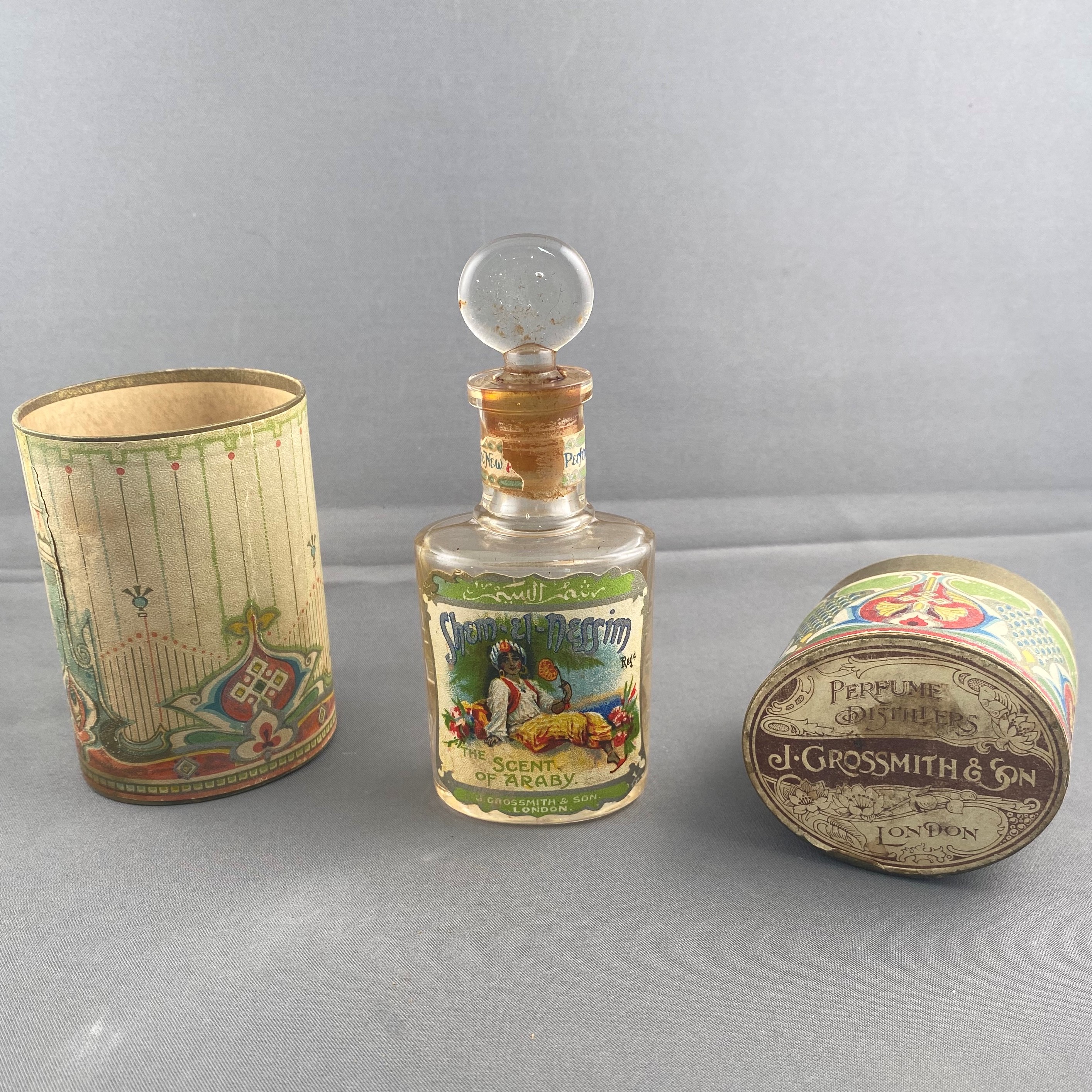J. Grossmith & Son Perfume Bottle
Object MC34 is a perfume bottle with outer packaging, which was produced by J. Grossmith and Son of London, a long-running perfume company which was created in 1835. The company was dissolved in 1980 but was recently revived by the descendants of the original owners. During the nineteenth century they enjoyed royal warrants in Britain, Greece, and Spain and were worn by nobles and royalty from across Europe.
Perfumes have been used by humans since ancient times, and could often be symbols of wealth, nationalism, religion, and status, as well as helping to mask the problem of body odour. These were made using spices or real flowers, which often increased the value and price for any customers wishing to use them. During the Victorian era, developments in the field of chemistry and technology allowed skilled perfumers to recreate the scent of several flowers using certain chemicals, creating a synthetic scent to use in their perfumes.
According to the Grossmith company website, this fragrance was first created in 1906 and was named “Shem-El-Nessim”, which when translated from Arabic means ‘smelling the breeze’. This would have been a perfume available only to the upper classes, due to the perfumes use of rare flowers and spices which comprise the scent, which were not synthetic.
J. Grossmith & Son ‘The Scent of Araby’ Perfume Bottle, MC34, Egham Museum Collections
The bright colours of the perfume bottle and outer packaging would have been eye-catching to potential buyers, and clearly draws inspiration from Middle Eastern art and decoration. At the start of the twentieth century there had been greater emphasis on the design of perfume bottles in the face of a growing market of high-end fragrances and greater competition for potential customers. This perfume may have been sold in high-end department stores, which catered for the upper classes of British society.
The advertising on the perfume bottle promotes the perfume as ‘the scent of Araby’. The perfumiers of the mid-nineteenth century crafted perfume around environments, such as scents that were created to smell like a trip to the Alps. Grossmith London had added to the trend in the 1880’s, with perfumes such as “Hasu-No-Hana” (1888), which translates from Japanese as “Lotus Flower”, and ‘Phul-Nana‘ (1891), which translates from Hindi as “Lovely Flower”. It is clear from these names that these perfumes were designed to invoke the smells of exotic lands for their customers.
This perfume therefore promoted the opportunity to ‘escape’ into a world of exotic adventure through smell, which would have appealed particularly to those who were unable to travel to the real places. The use of the Arabic at the top of the bottle from our collections reinforces the perfume’s exotic appeal, especially as not many people would have been able to read Arabic. It also adds an element of mysticism surrounding both the perfume and the landscape that it is meant to represent. Advertising campaigns promoting this perfume are themed around Egypt, which was controlled by British forces when this perfume was created and sold to customers.
At this time parts of the Middle East and Asia were heavily romanticised and seen as exciting and unpredictable environments, particularly by individuals back in Britain. Much of this was tied into British imperial ideology and conquest. While we may see items such as these as problematic and discriminatory, empire was openly celebrated at Britain and was a point of pride for many communities.
The women seen on the front of the perfume bottle is a racist stereotype of Arabic women, who were seen by British people as promiscuous.
Remarkably, this same perfume scent can still be bought today, yet the packaging no longer features the Arabic text, or the lady seen on the front of the original bottle.
Further Reading
‘HASU-NO-HANA’, Grossmiths London, <https://www.grossmithlondon.com/hasu-no-hana-1> [accessed 2nd January 2022].
‘PHUL-NANA’, Grossmiths London, <https://www.grossmithlondon.com/phul-nana-1> [accessed 2nd January 2022].
‘Shem-El-Nessim’, Grossmith London,< https://www.grossmithlondon.com/shemelnessim-1> [accessed 18th November 2021]. ‘Heritage: J. Grossmith & Son’, Grossmith London, <https://www.grossmithlondon.com/heritage-j-grossmith-and-son> [accessed 18th November 2021].
‘SHEM-EL-NESSIM’, Grossmiths London,<https://www.grossmithlondon.com/shemelnessim-1<accessed 2nd January 2022].
‘THE VICTORIANS: FROM VIOLET POSIES TO VA-VA-VOOM’, The Perfume Society<https://perfumesociety.org/history/the-victorians-from-violet-posies-to-va-va-voom/> [accessed 16th December 2021].
Dugan, Holly, The Ephemeral History of Perfume: Scent and Sense in Early Modern England (Baltimore: John Hopkins University Press, 2011).
Ellie Pithers, ‘Grossmith: scent by descent’, The Telegraph, 13th May 2013,http://fashion.telegraph.co.uk/beauty/news-features/TMG10054361/Grossmith-scent-by-descent.html>[accessed 2nd January 2022].

